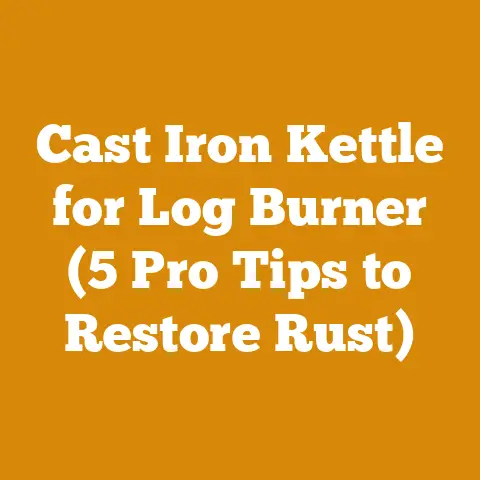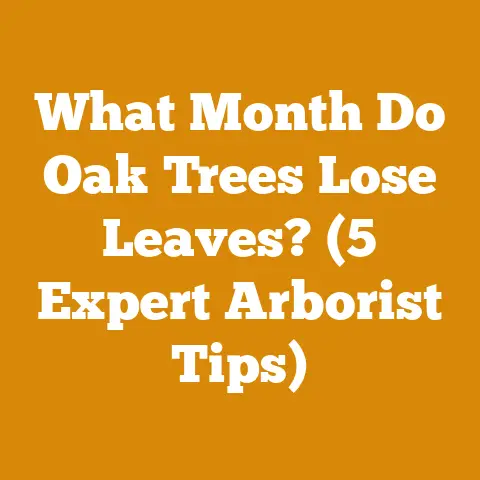Is Mesquite Good Firewood? (5 Expert Tips for Perfect Burn)
Sustainability isn’t just a buzzword; it’s the cornerstone of responsible wood processing and firewood preparation.
As someone who’s spent years knee-deep in sawdust and the satisfying aroma of freshly split wood, I’ve seen firsthand how mindful practices can benefit both our wallets and the environment.
So, let’s dive into the world of mesquite firewood and explore how to get the perfect burn while keeping an eye on both quality and cost.
Is Mesquite Good Firewood? (5 Expert Tips for Perfect Burn)
Mesquite.
The name conjures images of the American Southwest, smoky barbecue, and the crackling warmth of a desert campfire.
But is it good firewood?
The short answer is a resounding yes, but like any wood, there are nuances to consider.
The Allure of Mesquite: Heat, Aroma, and Burn Time
Mesquite is a hardwood, prized for its density and high heat output.
It burns hot and slow, making it an excellent choice for heating homes or cooking.
The distinctive aroma is a bonus, adding a delightful smoky flavor to anything cooked over it.
Here’s the breakdown:
- Heat Output: Mesquite boasts a BTU (British Thermal Unit) rating of around 20-25 million per cord.
This puts it in the upper echelon of firewood, rivaling oak and hickory. - Burn Time: Due to its density, mesquite burns for a long time, reducing the need for frequent stoking.
- Aroma: The signature smoky scent is highly desirable, particularly for cooking.
Personal Story: I once used mesquite to smoke a brisket for a family gathering.
The result was phenomenal – tender, juicy, and infused with that unmistakable mesquite flavor.
It was a hit!
The Downside: Sparks, Smoke, and Availability
While mesquite has many virtues, it also has a few drawbacks.
It tends to spark and pop more than other hardwoods, so it’s crucial to use a fireplace screen or spark arrestor.
Also, it can produce a fair amount of smoke, especially if not properly seasoned.
Availability can also be an issue, depending on your location.
Here’s what to watch out for:
- Sparking: Mesquite tends to throw sparks, making it less suitable for open fires or fireplaces without proper protection.
- Smoke: Unseasoned mesquite can produce a lot of smoke, which can be irritating and potentially hazardous.
- Availability: Mesquite is primarily found in the southwestern United States and parts of Mexico.
Sourcing it in other regions can be difficult and expensive.
Cost Consideration: Transporting mesquite long distances adds to its cost.
If you’re not in a mesquite-growing region, consider the added expense before committing to it.
5 Expert Tips for the Perfect Mesquite Burn
Now that we’ve established mesquite’s pros and cons, let’s get into the nitty-gritty of how to achieve the perfect burn.
Tip 1: Seasoning is Key
Seasoning, or drying, is absolutely critical for any firewood, but especially for mesquite.
Freshly cut mesquite can have a moisture content of 40-50%.
You want to get that down to 20% or less.
Why seasoning matters:
- Reduced Smoke: Dry wood burns much cleaner, producing less smoke.
- Higher Heat Output: Wet wood wastes energy evaporating moisture, reducing its heat output.
- Easier Ignition: Dry wood ignites much more easily than wet wood.
How to season mesquite:
- Split the wood: Splitting exposes more surface area, accelerating the drying process.
- Stack it properly: Stack the wood in a single row, off the ground, with good air circulation.
- Allow ample time: Mesquite typically takes 6-12 months to season properly.
Personal Story: I remember one winter trying to burn unseasoned mesquite.
It was a smoky, sputtering mess.
It taught me a valuable lesson about the importance of patience!
Cost Consideration: While seasoning doesn’t cost much in terms of money, it does require time and space.
Factor this into your firewood preparation timeline.
The longer you season, the better and more efficient the burn, saving you money in the long run.
Tip 2: Know Your Mesquite Varieties
There are several species of mesquite, each with slightly different characteristics.
The two most common are honey mesquite ( Prosopis glandulosa) and velvet mesquite (Prosopis velutina).
Honey Mesquite:
- Generally considered to be the best for firewood.
- Burns hotter and longer.
- Has a slightly sweeter aroma.
Velvet Mesquite:
- Burns well, but not quite as hot as honey mesquite.
- May have a slightly more pungent aroma.
Cost Consideration: Honey mesquite is often slightly more expensive than velvet mesquite due to its superior burning qualities.
I recommend asking your supplier about the specific species they are selling.
Tip 3: Start with a Hot Fire
Mesquite needs a good, hot fire to get going.
Use kindling and tinder to establish a strong base before adding larger pieces of mesquite.
Tips for starting a hot fire:
- Use dry kindling: Small, dry twigs and branches are essential for getting the fire started.
- Arrange the kindling in a teepee or log cabin: This allows for good air circulation.
- Use a fire starter: Commercial fire starters or natural alternatives like pine resin can help get the fire going quickly.
Personal Story: I’ve found that using small pieces of fatwood (pine wood saturated with resin) works wonders for starting a fire.
It burns hot and long, giving the mesquite a good head start.
Cost Consideration: Fire starters can add to the overall cost, but they can also save you time and frustration.
Consider the trade-off between cost and convenience.
Tip 4: Control the Airflow
Once the fire is established, controlling the airflow is crucial for maintaining a consistent burn.
Too much air will cause the fire to burn too quickly, while too little air will smother it.
Tips for controlling airflow:
- Adjust the damper: Most fireplaces have a damper that controls the amount of air entering the firebox.
- Use a grate: A grate elevates the wood, allowing air to circulate underneath.
- Experiment with different wood arrangements: Try different arrangements to see what works best for your fireplace.
Cost Consideration: A good fireplace grate is a worthwhile investment.
It improves airflow and helps the wood burn more efficiently, saving you money in the long run.
Tip 5: Be Mindful of Sparks
As mentioned earlier, mesquite tends to spark, so it’s important to take precautions to prevent fires.
Safety precautions:
- Use a fireplace screen or spark arrestor: This will prevent sparks from escaping the fireplace.
- Keep flammable materials away from the fireplace: This includes rugs, curtains, and furniture.
- Never leave a fire unattended: Always supervise the fire and make sure it’s completely extinguished before leaving the house or going to bed.
Personal Story: I once had a small ember escape my fireplace and land on a nearby rug.
Luckily, I caught it in time, but it was a close call.
It reinforced the importance of always being vigilant around fires.
Cost Consideration: A good fireplace screen is a relatively inexpensive safety measure that can prevent costly damage.
The Economics of Mesquite Firewood: A Cost Breakdown
Now, let’s delve into the financial aspects of using mesquite firewood.
The cost of firewood can vary significantly depending on several factors, including location, availability, and the quantity purchased.
Factors Influencing Mesquite Firewood Costs
- Location: As mentioned earlier, mesquite is primarily found in the southwestern United States and parts of Mexico.
The further you are from these regions, the more expensive it will be. - Availability: The supply of mesquite firewood can fluctuate depending on factors like weather conditions and harvesting regulations.
- Quantity: Firewood is typically sold by the cord, half cord, or rick (face cord).
Buying in larger quantities usually results in a lower price per unit. - Seasoning: Seasoned firewood is more expensive than unseasoned firewood because it requires time and effort to dry.
- Delivery: Delivery charges can add to the overall cost.
Personal Story: I live in Texas, where mesquite is readily available.
This gives me a significant advantage in terms of cost compared to someone living in, say, Maine.
Cost Components: A Detailed Look
Let’s break down the various cost components involved in acquiring and preparing mesquite firewood.
1. Timber Purchase or Harvesting Costs:
- Purchasing Mesquite Logs: If you’re buying logs directly from a timber company, the price will depend on the species, size, and quality of the logs.
In Texas, I’ve seen mesquite logs selling for around \$50-\$100 per ton. - Harvesting Your Own Mesquite: If you have access to mesquite trees on your property, you can harvest your own firewood.
However, you’ll need to factor in the cost of equipment like a chainsaw, fuel, and safety gear.
Data Point: According to the USDA Forest Service, the average stumpage price (the price paid to the landowner for standing timber) for hardwoods in the Southwest ranges from \$20-\$50 per ton.
2. Tool Costs:
- Chainsaws: A good quality chainsaw is essential for cutting mesquite logs into manageable pieces.
Prices range from \$200 for a basic model to \$1000 or more for a professional-grade saw. - Axes and Splitting Mauls: These tools are used to split the wood into smaller pieces for seasoning and burning.
Prices range from \$50-\$200. - Log Splitters: A log splitter can save you a lot of time and effort, especially if you’re processing large quantities of firewood.
Prices range from \$500 for a manual splitter to \$3000 or more for a hydraulic splitter. - Safety Gear: Safety glasses, gloves, chaps, and a helmet are essential for protecting yourself while working with wood.
Expect to spend around \$100-\$200 on safety gear.
Personal Story: I’ve found that investing in quality tools pays off in the long run.
A good chainsaw will last for years and make the job much easier.
Cost Consideration: Consider renting a log splitter if you only need it occasionally.
Rental fees typically range from \$50-\$100 per day.
3. Labor Costs:
- Hiring a Logging Crew: If you’re dealing with a large quantity of wood, you may want to hire a logging crew to help with the harvesting and processing.
Labor costs can vary depending on the size of the crew and the complexity of the job. - DIY Labor: If you’re doing the work yourself, factor in the value of your time.
How much is your time worth per hour?
Be realistic about how long it will take you to complete the job.
Data Point: According to the Bureau of Labor Statistics, the median hourly wage for logging workers in the United States is around \$20.
4. Fuel and Maintenance Costs:
- Chainsaw Fuel and Oil: Chainsaws require a mixture of gasoline and oil.
The cost of fuel and oil will depend on the amount of wood you’re processing. - Tool Maintenance: Chainsaws and log splitters require regular maintenance, including sharpening the chain, changing the oil, and replacing worn parts.
- Vehicle Costs: If you’re transporting firewood, factor in the cost of fuel, maintenance, and depreciation on your vehicle.
Personal Story: I always make sure to sharpen my chainsaw chain regularly.
A sharp chain cuts more efficiently and reduces the risk of kickback.
Cost Consideration: Regular maintenance can extend the life of your tools and prevent costly repairs.
5. Permits and Regulations:
- Harvesting Permits: In some areas, you may need a permit to harvest firewood from public lands.
- Transportation Regulations: There may be regulations regarding the transportation of firewood across state lines to prevent the spread of invasive species.
Data Point: Check with your local and state forestry agencies for information on harvesting permits and transportation regulations.
Case Study: Budgeting for a Cord of Mesquite Firewood
Let’s create a hypothetical budget for acquiring and preparing a cord of mesquite firewood.
Scenario: You live in central Texas and have access to mesquite trees on your property.
You plan to harvest and process the firewood yourself.
Cost Breakdown:
- Chainsaw Fuel and Oil: \$20
- Axe and Splitting Maul: \$100 (one-time investment, amortized over several years)
- Safety Gear: \$150 (one-time investment, amortized over several years)
- Your Labor (20 hours at \$20/hour): \$400
- Vehicle Costs (transporting firewood): \$50
- Permits (if required): \$20
Total Cost: \$640
Cost per Cord: \$640
Market Comparison: The average price for a cord of seasoned mesquite firewood in central Texas is around \$250-\$400.
In this scenario, harvesting your own firewood is significantly more expensive, primarily due to the value of your labor.
Cost Optimization:
- Reduce Labor Time: Find ways to increase your efficiency and reduce the amount of time it takes to harvest and process the firewood.
- Share Equipment: Partner with a neighbor or friend to share the cost of expensive tools like a log splitter.
- Buy in Bulk: If you’re buying firewood, consider buying in bulk to get a lower price per unit.
Industry Benchmarks and Statistical Data
- Average Price per Cord of Firewood: According to the USDA Forest Service, the average price for a cord of firewood in the United States ranges from \$150-\$400, depending on the species and location.
- Fuelwood Consumption: The Energy Information Administration (EIA) estimates that approximately 2% of US households use wood as their primary heating source.
- Timber Prices: Timber prices fluctuate depending on market conditions and demand.
Stay informed about current timber prices in your area by consulting with local timber companies and forestry agencies.
Cost Optimization Strategies
- Negotiate Prices: Don’t be afraid to negotiate prices with firewood suppliers.
- Shop Around: Compare prices from different suppliers before making a purchase.
- Season Your Own Firewood: Seasoning your own firewood can save you money compared to buying pre-seasoned wood.
- Use Efficient Burning Techniques: Learn how to burn firewood efficiently to maximize heat output and reduce waste.
Technical Explanations and Calculations
- Calculating Volume of Logs: The volume of a log can be estimated using various formulas, such as the Doyle Log Scale or the Scribner Log Scale.
These scales provide an estimate of the number of board feet (a unit of lumber volume) that can be sawn from a log. - Estimating Drying Time: The drying time for firewood depends on factors like the species of wood, the size of the pieces, and the climate.
A general rule of thumb is that hardwoods like mesquite require 6-12 months to season properly. - Moisture Content Measurement: A moisture meter can be used to measure the moisture content of firewood.
Aim for a moisture content of 20% or less for optimal burning.
Formula:
- Doyle Log Scale: Board Feet = (Diameter in inches – 4)² x Length in feet / 16
Example: A log that is 16 inches in diameter and 10 feet long would have an estimated volume of (16-4)² x 10 / 16 = 90 board feet.
Challenges Faced by Small-Scale Loggers and Firewood Suppliers
Small-scale loggers and firewood suppliers face numerous challenges, including:
- Fluctuating Timber Prices: Timber prices can be volatile, making it difficult to predict profitability.
- Competition from Larger Companies: Larger companies often have economies of scale that allow them to offer lower prices.
- Regulatory Compliance: Complying with environmental regulations and safety standards can be costly and time-consuming.
- Weather Conditions: Inclement weather can disrupt harvesting operations and reduce productivity.
Actionable Takeaways and Next Steps
- Assess Your Needs: Determine how much firewood you need and whether you want to buy it or harvest it yourself.
- Research Local Suppliers: Find reputable firewood suppliers in your area and compare prices.
- Invest in Quality Tools: If you plan to harvest your own firewood, invest in quality tools and safety gear.
- Season Your Firewood Properly: Allow ample time for your firewood to season before burning it.
- Practice Safe Burning Techniques: Always follow safe burning practices to prevent fires.
- Stay Informed: Keep up-to-date on current timber prices, regulations, and best practices for firewood preparation.
Mesquite firewood is a fantastic choice for heating and cooking, but it’s crucial to approach it with knowledge and preparation.
By understanding the factors influencing cost, implementing efficient practices, and prioritizing safety, you can enjoy the warmth and aroma of mesquite while staying within your budget.
Remember, sustainability and cost-effectiveness go hand in hand.






